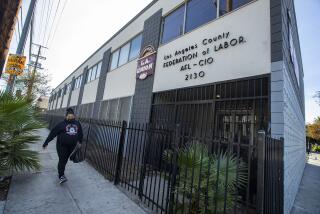Nixon Taped All, but Talks Can Be Difficult to Decipher
- Share via
WASHINGTON — He puts his feet on the desk and you hear a thunderous boom. He rattles his coffee cup on a saucer and you swear the house is coming down. That’s because the notorious Oval Office recordings of former President Nixon magnify every sound, from whispers to extraneous noises.
Southern Californians may be able to hear it for themselves at the Nixon Library and Birthplace in Yorba Linda, once a legal settlement with the National Archives is reached.
But be forewarned--the most remarkable and unusual materials of any former president are also the most difficult to decipher. The 3,700 hours of secret recordings, covering meetings and phone calls over a two-year period, are so marred by background noises that many conversations are hard to figure out.
About half the tapes contain no conversations at all. The system was sound-activated, but it was so sensitive that virtually any noise turned the tapes on.
“We’ve listened to literally hundreds of hours with nothing but the sound of cleaning crews vacuuming the president’s office,” one archivist remarked. “Police sirens in the middle of the night triggered the tapes, and some recordings have only the sound of daytime traffic when Nixon was away.”
The archives to date has made available about 260 hours of his talks with top aides, having deleted national security secrets and private family matters in response to years of litigation by Nixon, who died in 1994, and his heirs. To hear the tapes, one must travel to a facility the archives operates in suburban Maryland.
But talks now underway could move the tapes and other materials to the privately run Nixon library as part of a multimillion-dollar settlement with his estate.
The famous recordings are rich in history.
Nixon, hoping to have the best documented presidency ever, ordered the Secret Service to install the elaborate taping system in February 1971. Only his closest confidant, Chief of Staff H.R. Haldeman, and two personal assistants knew about the project.
Five microphones were embedded in the president’s Oval Office desk. Two others were placed in the Cabinet Room. The Lincoln Sitting Room and the president’s hideaway in the Old Executive Office Building, adjacent to the White House, also were wired, as well as three phones that Nixon used in the White House complex. The next year, the presidential retreat at Camp David, Md., was similarly equipped.
Little did Nixon realize he was sealing his fate. When then-White House Counsel John Dean publicly accused him of directing a criminal cover-up of the June 1972 break-in of Democratic headquarters at the Watergate Hotel, the tapes backed up the charges.
Nixon had left the machinery whirring even through conspiratorial talks, apparently believing that he could never be forced to turn over such secret evidence of wrongdoing.
But he ordered the taping system dismantled in July 1973, after its existence was revealed to the Senate Watergate Committee by a mid-level aide, Alexander Butterfield.
The Supreme Court’s ultimate ruling in mid-1974 that Nixon must surrender the tapes led not only to his resignation in the face of certain impeachment, but to a potential treasure trove of material for historians and the general public.
For years, however, Nixon fought to maintain control of the recordings, challenging an act of Congress that had placed them under government jurisdiction. Congress said it was acting to keep Nixon from destroying his tapes, which, it said, were of “general historical significance,” as well as of legal importance to the various Watergate-related trials.
The Supreme Court ultimately sided with Congress, saying the archives could begin processing the tapes so that historians and the public could hear them. But Nixon then delayed the process further by contesting, point by point, government regulations surrounding their release.
Two years after his death, Nixon’s heirs agreed to allow the tapes to be heard after strictly private matters were removed. But based on a 1992 court ruling, the estate must be compensated.
More to Read
Sign up for Essential California
The most important California stories and recommendations in your inbox every morning.
You may occasionally receive promotional content from the Los Angeles Times.










